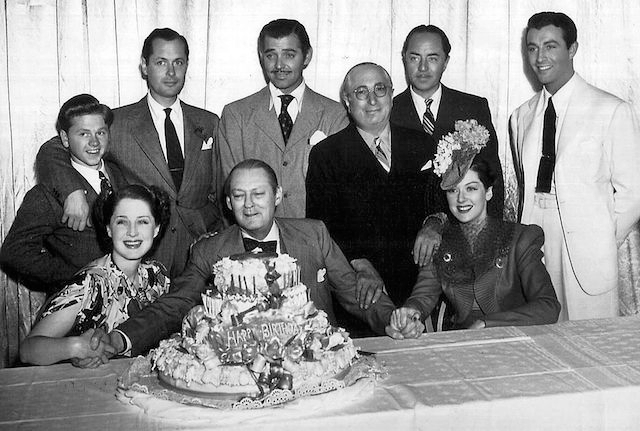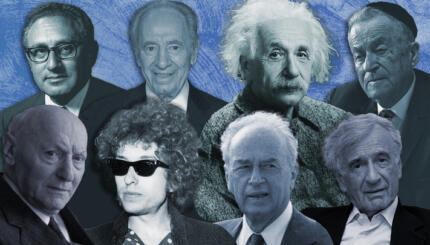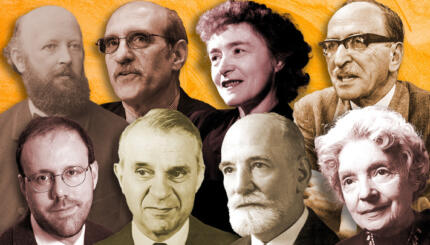Philip French’s The Movie Moguls and Nolan Zierold’s The Moguls give good overviews and collective/comparative portraits of the small group of top-level Jewish-born entrepreneurs who fashioned the [Hollywood] dream factories, Marcus Loew, Adolph Zukor, Sam Goldwyn, Carl Laemmle, the Selznicks, Jesse Lasky, William Fox, the Warner Brothers, Louis B. Mayer, B. P. Schulberg and Harry Cohn.
Having either been born in America or come from Europe in their childhood or youth, most of the moguls could be classified as second-generation American Jews, from poor or modest-income families. They were exceptionally industrious and ambitious, and, interestingly, quite a few came to the motion picture industry from various retail trades, particularly the garment industry. Zukor and Loew, for example, began as furriers, Fox and Laemmle as clothing merchants, Goldwyn as a glove salesman. Control was enterprisingly gained over theaters and, later, over studios, linking distribution and production.

The creation of the two industries was not utterly dissimilar. Both in clothing and motion pictures Jewish entrepreneurs, starting from a mass distribution base, created mass production industries for garments and entertainment. With daring and finesse, they organized innumerable individual skills (of sewing or photographing) for the vast market of voiceless consumers.

Help us keep Jewish knowledge accessible to millions of people around the world.
Your donation to My Jewish Learning fuels endless journeys of Jewish discovery. With your help, My Jewish Learning can continue to provide nonstop opportunities for learning, connection and growth.
The moguls, thus, brought to Hollywood certain business skills acquired in related retail trades and, by the 1930s, six of the eight major studios were Jewishly controlled and managed. In addition, persons of Jewish birth were prominent among the second and third level of business-oriented producers, managers, assistants, agents and lawyers.
How Jewish Was Jewish Hollywood?
What was the shape of the formal or explicit religious Judaism and ethnic Jewishness practiced and expressed by Jewish Hollywood? During this period, almost no films were made about specifically Jewish settings, experiences, or characters. Though most of the moguls came from observant Jewish homes, and learned some Hebrew and/or had been bar mitzvahed, they tended, as adults, to live and think in a culturally assimilated lifestyle removed from the cultural content, activities or practices of the Jewish heritage, or of the affairs of the larger Los Angeles Jewish community. Theirs was a somewhat passive though unashamed Jewishness, comprised usually of the use of some Yiddish words, temple membership but infrequent attendance, and support for Jewish philanthropy. Screenwriter Ben Hecht has rather caustically characterized and explained the stance as follows:
He finds it convenient to forget his Jewishness in the high-class world into which he has vaulted. He is thus eager. to prove his Jewishness secretly by donations to Jews in distress. He will support a synagogue with large gifts for thirty years without ever entering it. The closest he comes to this secret Judaism to which he stubbornly lays claim is observing a few religious principles, such as not going to the races on Jewish holidays, or arranging for a rabbi to officiate (in English) at his funeral.
Louis Mayer, head of M-G-M, was probably fairly typical in this respect. Once away from the Orthodoxy of his Boston youth, he tended to treat his religion “rather casually;” he did belong to a temple, but rarely attended. Some, of course, were more disaffected. David Selznick, not wanting to be considered a Hollywood Jew, once told Hecht, “I’m an American and not a Jew.” Harry Cohn, of Columbia, avoided temples, and at his “nondenominational” funeral in 1958 no reference was made to his Jewish birth and origins. His biographer relates that:
One afternoon Louis B. Mayer spent an hour on the telephone before he was able to evoke a contribution from Cohn to Jewish Relief. Mayer used all his considerable powers of persuasion to appeal to Cohn’s loyalties as a Jew, but Cohn had none. After he committed himself to a sizable donation, Cohn complained to an aide, “Relief for the Jews! Somebody should start a fund for relief from the Jews. All the trouble in the world has been caused by Jews and Irishmen.”
While not very culturally Jewish, Jewish Hollywood was somewhat socially separate in structure, making up its own social circle (or circles, of various levels and roles in the pecking order) of Jewish friends and associates for job nepotism, art collecting, the country club, golf, gambling and even intra-colony marriage (such as that of Louis B. Mayer’s daughter to David Selznick).
The Importance of Being an Immigrant
If Jewish Hollywood had little explicit Judaism or Jewishness to contribute to those foundation years of sound films, what, then, was its motive power? Both Zierold and French more or less detect that there was something about its “immigrant-ness” that lay behind the achievements, strengths, and shortcomings.
First, their desire as immigrants or near-immigrants to be fully accepted as culturally assimilated “Americans,” “one hundred per cent Americans,” lent them an enthusiasm for the transmission, idealization, and creation of American popular culture. Through their movies, they presented to the world their own selective perception of aspects of American values and virtues.
Second, it has frequently been contended that, as immigrants becoming Americans, they had a special sense of, or “instinct” for, what the movie-goer wanted and liked, which was usually what they, as typical or, at least aspirant, mass Americans, wanted and liked. Cohn, for example, once ordered a three-syllable word to be taken out of a script because, “If I don’t know what it means, the average guy in a movie theater sure as hell won’t.” And he had a “foolproof” method to determine the quality of a film: “If my fanny squirms, it’s bad. If my fanny doesn’t squirm, it’s good. It’s as simple as that.” Goldwyn’s stomach was his guide. In retrospect, it appears that their intuitive judgments were correct more often than not.
This immigrant enthusiasm for American popular culture, and this understanding of mass American tastes, took different shapes and forms at the different “Jewish studios.” While M-G-M, for instance, under Mayer, turned out pictures that have been described as folksy, romantic, sentimental, glossy, “feminine” films for the middle class, the Warner Brothers, under Jack Lo Warner, produced “less ladylike” crime stories, melodramas, biographies, and “social conscience” films for and about the working class. Both sets of films were variations on themes of American popular culture, as seen through historical immigrants’ lenses.
Reprinted with permission from Judaism: A Quarterly Journal of Jewish Life and Thought.



